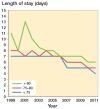Longer hospital stay, more complications, and increased mortality but substantially improved function after knee replacement in older patients
- PMID: 25885004
- PMCID: PMC4513600
- DOI: 10.3109/17453674.2015.1040304
Longer hospital stay, more complications, and increased mortality but substantially improved function after knee replacement in older patients
Abstract
Background and purpose: Total knee replacement (TKR) is being increasingly performed in elderly patients, yet there is little information on specific requirements and complication rates encountered by this group. We assessed whether elderly patients undergoing TKR had different length of stay, requirements, complication rates, and functional outcomes compared to younger counterparts.
Patients and methods: We analyzed prospectively gathered data on 3,144 consecutive primary TKRs (in 2,092 patients aged less than 75 years, 694 patients aged between 75 and 80 years, and 358 patients aged over 80 years at the time of surgery).
Results: Incidence of blood transfusion, urinary catheterization, postoperative confusion, cardiac arrhythmia, and 1-year mortality increased with age, even after adjusting for confounding factors, whereas the incidences of chest infection and mortality at 1 month were highest in those aged 75-80. Rates of thromboembolism, prosthetic infection, and revision were similar in the 3 age groups. All groups showed similar substantial improvements in American Knee Society (AKS) knee scores, which were maintained at 5 years. Older patients had smaller improvements in AKS function score, which deteriorated between 3 and 5 years postoperatively, in contrast to the younger group.
Interpretation: Elderly people stand to gain considerably from TKR, particularly in terms of pain relief, and they should not be denied surgery based solely on age. However, they should be warned that they can expect a longer length of stay, a higher requirement for blood transfusion and/or urinary catheterization, and more medical complications postoperatively. Mortality was also higher in the older age groups. The risks have been quantified to assist in perioperative counselling, informed consent, and healthcare planning.
Figures
Comment in
-
An enhanced treatment program with markedly reduced mortality after a transtibial or higher non-traumatic lower extremity amputation.Acta Orthop. 2016 Jun;87(3):306-11. doi: 10.3109/17453674.2016.1167524. Epub 2016 Apr 18. Acta Orthop. 2016. PMID: 27088484 Free PMC article.
References
-
- Amar D, Zhang H, Leung DH, Roistacher N, Kadish AH. Older age is the strongest predictor of postoperative atrial fibrillation . Anesthesiology. 2002;96(2):352–356. - PubMed
-
- Anderson JG, Wixson RL, Tsai D, Stulberg SD, Chang RW. Functional outcome and patient satisfaction in total knee patients over ... . J Arthroplasty. 1996;11(7):831–840. - PubMed
-
- Arden N, Nevitt MC. Osteoarthritis: epidemiology . Best Pract Res Clin Rheumatol. 2006;20(1):3–25. - PubMed
-
- Baker PN, van der Meulen JH, Lewsey J, Gregg PJ. The role of pain and function in determining patient satisfaction after ... . J Bone Joint Surg Br. 2007;89(7):893–900. - PubMed
-
- Benjamin EJ, Levy D, Vaziri SM, D’Agostino RB, Belanger AJ, Wolf PA. Independent risk factors for atrial fibrillation in a population-based c... . JAMA. 1994;271(11):840–844. - PubMed
Publication types
MeSH terms
LinkOut - more resources
Full Text Sources
Other Literature Sources
Medical


